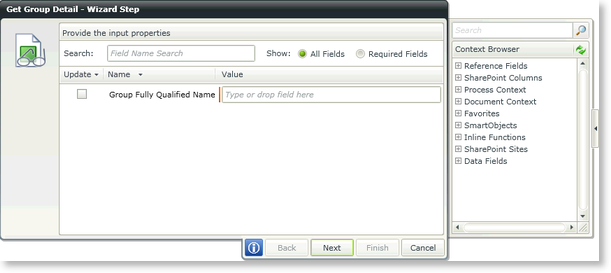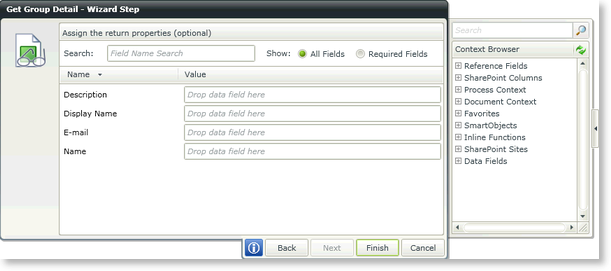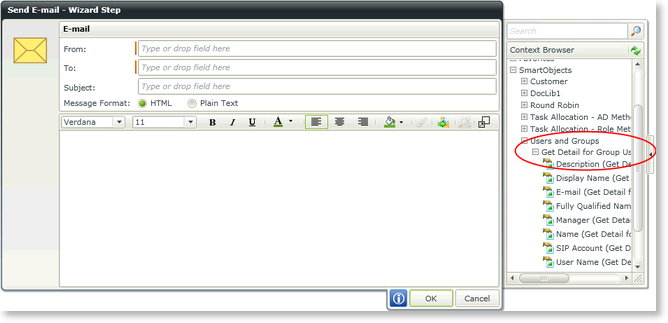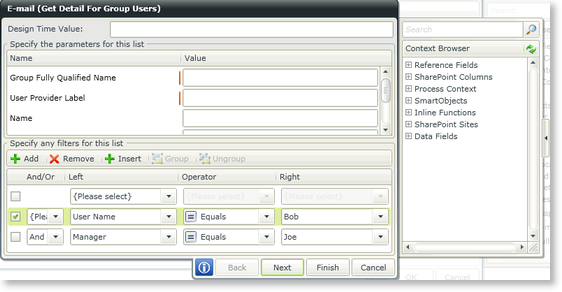Users and Groups SmartObject
 |
It is important to note that SmartObjects will only be available in the SmartObjects tool bar once it has been configured on the Configure SmartObject Access page |
The Users and Groups SmartObject is created by default when installing K2. It contains a Single Method and a List Method which can be used in the following K2 field types which resolves to E-mail addresses:
- Value
- Data Field
- XML Field
- Function Field
- User Field (User, Group or Role)
This in effect means that this SmartObject can be used in any of the above K2 fields to return E-mail addresses.
Single Method
The Single Methods of the Users and Groups SmartObject can be found by selecting the SmartObjects tab in the K2 Designer for SharePoint, then selecting the Users and Groups SmartObject from the list of SmartObjects available.There are 2 methods available:
- Get User Detail - A single E-mail address is returned
- Get Group Detail - A single E-mail address is returned

| Get User Detail | What it is | How to use it |
|---|---|---|
| UserName | UserName property returned from the URM | Select the property and click Add |
| Name | Name property returned from the URM | Select the property and click Add |
| Description | Description property returned from the URM | Select the property and click Add |
| E-mail address of the User/Group returned from the Users and Groups SmartObject | Select the property and click Add | |
| Manager | Manager property returned from the URM | Select the property and click Add |
| SIP Account | SIP Account property returned from the URM | Select the property and click Add |
| DisplayName | DisplayName property returned from the URM | Select the property and click Add |
| Get Group Detail | What it is | How to use it |
|---|---|---|
| UserName | UserName property returned from the URM | Select the property and click Add |
| Name | Name property returned from the URM | Select the property and click Add |
| Description | Description property returned from the URM | Select the property and click Add |
| E-mail address of the User/Group returned from the Users and Groups SmartObject | Select the property and click Add |
 |
The Properties returned depends on the User Relationship Manager used together with K2. The reason for surfacing the URM properties, is to support system wide usage. |
The Input Properties screen opens when a method is dragged onto the canvas. Supply details for the input mapping if required and click Next.

The Return Properties screen is displayed. Specify the return properties and click Finish.

List Method
The List Methods of the Users and Groups SmartObject can be found by expanding the SmartObjects node in the Context Browser, then navigating to Users and Groups. Drag the property into the required field. There are 2 methods available for the List Method:
- Get Detail for Group Users - A list of E-mail addresses is returned
- Get Detail for Role Users - A list of E-mail addresses is returned

| Get Detail for Group Users | What it is | How to use it |
|---|---|---|
| FQN | Fully Qualified Name property returned from the URM | Select the property and click Add |
| UserName | UserName property returned from the URM | Select the property and click Add |
| Name | Name property returned from the URM | Select the property and click Add |
| Description | Description property returned from the URM | Select the property and click Add |
| A list of E-mail addresses is returned from the Users and Groups SmartObject | Select the property and click Add | |
| Manager | Manager property returned from the URM | Select the property and click Add |
| SIP Account | SIP Account property returned from the URM | Select the property and click Add |
| DisplayName | DisplayName property returned from the URM | Select the property and click Add |
| Get Detail for Role Users | What it is | How to use it |
|---|---|---|
| FQN | Fully Qualified Name property returned from the URM | Select the property and click Add |
| UserName | UserName property returned from the URM | Select the property and click Add |
| Name | Name property returned from the URM | Select the property and click Add |
| Description | Description property returned from the URM | Select the property and click Add |
| A list of E-mail addresses is returned from the Users and Groups SmartObject | Select the property and click Add | |
| Manager | Manager property returned from the URM | Select the property and click Add |
| SIP Account | SIP Account property returned from the URM | Select the property and click Add |
| DisplayName | DisplayName property returned from the URM | Select the property and click Add |
 |
The Properties returned depends on the User Relationship Manager used together with K2. The reason for surfacing the URM properties, is to support system wide usage. |
The SmartObject Wizard opens and the parameters screen is displayed. Specify the values for the required input properties. A Filter can be applied to decrease the number of results to be returned. Click Next.

| Filter Options | What it is | How to use it |
|---|---|---|
| Add | Adds a new instance of a filter | Click Add to add a new instance of a filter |
| Remove | Removes an existing instance of a filter | Select a filter, then click Remove |
| Insert | Inserts a new instance of a filter above the filter that is currently selected | Select a filter, then click Insert |
| Group | Groups two or more instances of a filter together | Select the instances and click Group |
| Ungroup | Undo the grouping of instances of a filter | Select the instances and click UnGroup |
The Return property screen is displayed. Select the property to be returned. Results can be ordered Ascending or Descending. Select the option most suitable from the List Options to return the list. Click Finish.

| Order Options | What it is | How to use it |
|---|---|---|
| Order results by | Results can be ordered Ascending or Descending | Select the option |
| Property | This is the property that will be returned | Select the property from the Context Browser |
| List Options | What it is | How to use it |
|---|---|---|
| Return a single item | Returns only a single item as specified in the Select item drop down or Index field | Choose First, Last or Index from the Select item drop down |
| Select item |
The following options are available from the drop down":
|
Select the required option from the list |
| Index | A specific item can be specified to be returned | Select Index from the Select item drop down and type the item number that should be returned, i.e. 5 |
| Return all items that match filter | Returns all the items that match the filter criteria | Select the option |
